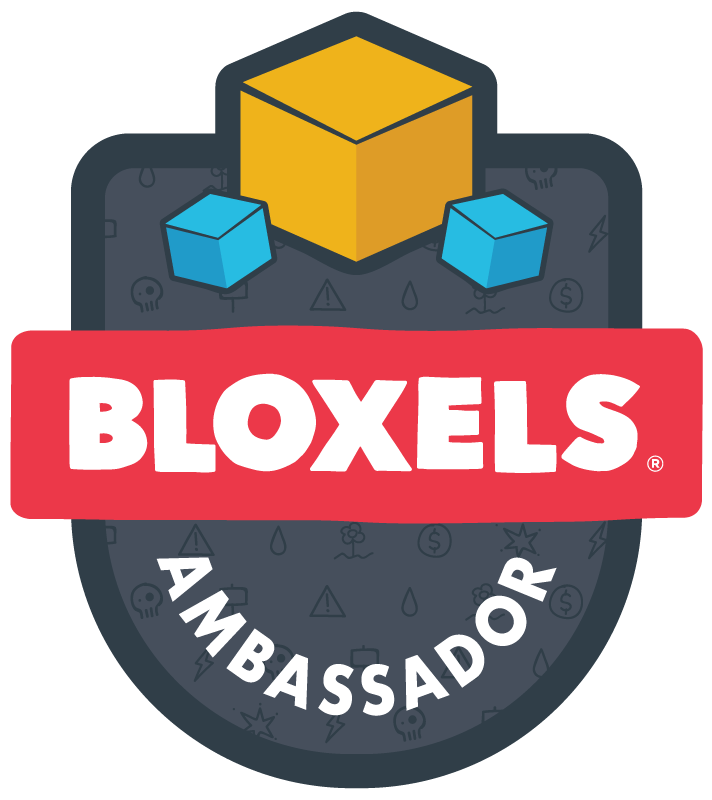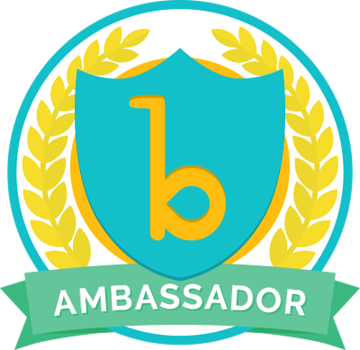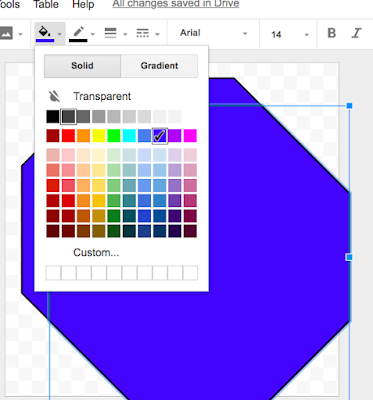Saturday, February 24, 2018
Creating Digital Badges With Google Drawings
9:38 AM
I have been exploring the world of digital badges for quite some time now. It's a great way to give students a sense of accomplishment and promote their learning. The most difficult for me was finding a way to share the badges with my students. The class I teach Information Literacy, which is really changing to Design Technology (the name will be changed formally by next year) is comprised of many technology projects. Each project is sent to my students through Google Classroom. Yes, we have gone completely paperless, and it's a beautiful thing :) Students receive directions to the project, any links and documents, and a copy of the rubric. My idea is to add the digital badge they receive directly to the rubric. They will be able to save this badge and add it directly to their Google Sites, which serves as a Digital Portfolio. If you are interested in creating a Digital Portfolio for your students through Google Sites, please see my most recent blog post.
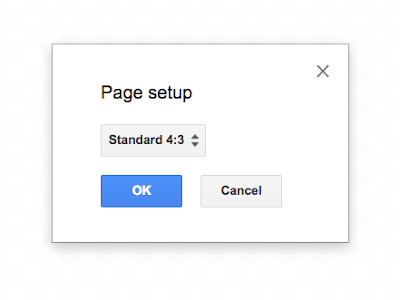

Here is What I came up with when I created a digital badge for completing their Google Site
The most common question I get when I show this badge to people is how did you create this. Well, it really is quite simple. The steps below will describe the process I took using Google Drawings.
1. Go to your Google Drive, Choose More and open up a new Google Drawings
2. The first thing you want to do is make your background transparent. This will allow the badge to show the graphics and you won't get a white background.
3. Next, you will want to change the size. We are making badges so you will want them to be relatively small. Go to File and choose Page Setup.

Choose Custom
Next, change from inches to Pixels and type in 192 X 192 and Click OK
You will notice that your working area is now much smaller.
4. Now it's time to start designing your badge. Go to Shapes and choose a shape you would like to use. I like to use the Octagon shape, but you can choose a shape you like best.
Draw Your Shape and then click on it, so you can fill in your shape with a color. I like to take up the full space, and leave only about one squares length of space on either side.
Once your shape is selected go up the paint bucket and choose a color.
5. Now it's time to start adding in a graphic or graphics that would like to add. Go to upload and add the pictures/graphics you want to add to your badge.
Make sure you have selected your image, so you can resize the graphic to fit inside your badge. I like to add an image from my bitmoji, which is available as a Chrome Extension. This is done by right clicking on the image and choosing copy. Then right clicking once I get to my working area and clicking on paste.
6. The next step is adding the Text for your Badge. Click on The T at the top of your menu and draw a text box in your badge. I like to keep my font in between size 10 and 12, and choose an interesting font.
Next, type in your text. If I am using a dark background, I like to use a light font.
7. If you want to add a shadow effect, this can be accomplished by clicking on your badge and selecting the shape. Next you right click and choose copy, and right click again to choose Paste.
Click on the paint bucket, and choose a darker color, for a shadowed effect. Next, click on arrange on the menu and choose send to back. You may need to resize a bit to get the full shadow effect.
8. Name your Badge.
Go to file and choose Download. Download as a PNG Image. Your file will now be available for you whenever needed.
I hope this tutorial was helpful in learning how to create your own digital badges. I would love to see badges that you are creating. Please share with me :)

Sunday, February 18, 2018
Creating a Digital Portfolio For Students With Google Sites
7:36 PM
My students are doing some phenomenal projects in the Information Literacy course I teach, so I decided to give them a way to save all their work in a digital portfolio using Google Sites. There are many different platforms I could have used such as Edublogs, Wix, or Weebly, just to name a few. I choose to use Google Sites as our platform. The new Google Sites is very easy to use, and although users don't have a lot of choices with design, it's a really good first website creation tool for upper elementary and middle school level students. I also like the fact that Google has different levels of privacy, so students have the ability to create a website, publish it to the web, but keep it available only to our school district.
Google Sites is very easy to use. My 6th, 7th and 8th graders all had a very easy time creating their sites. They were asked to create a site to use as a portfolio for all the work they would complete for the year. In the future they will add a page for their new grade level.

Google Sites is very easy to use. My 6th, 7th and 8th graders all had a very easy time creating their sites. They were asked to create a site to use as a portfolio for all the work they would complete for the year. In the future they will add a page for their new grade level.
Directions For Using New Google Sites
- Go to Google Sites https://sites.google.com/
- Choose New Google Sites.
- Begin by editing your Header. You can easily change the background image and give your site a name.
- It is also easy to give your site a theme, which will change your header by clicking on themes.
- Ready to add Text, images, You Tube Videos, Stuff from Google Drive, or even Embed items on your site? Google Makes it super easy. Just head over to the insert Section of Google Sites Editing.
- Need to add a new page. Again this is very easy with Google Sites. Head over to the Pages tab and click on the plus sign located on the bottom right hand edge of the menu.
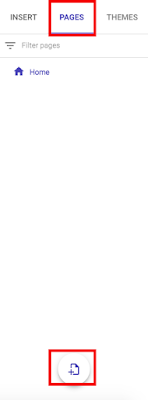
- Students will need to remember to click on publish in order for all edits to go to the live web version. The first time they publish they will need to add a distinct word or letters to create a URL for their site. I simply had my students add their first initial and last name.
Here are some samples of some of my student's beginning portfolios.

- Students will need to remember to click on publish in order for all edits to go to the live web version. The first time they publish they will need to add a distinct word or letters to create a URL for their site. I simply had my students add their first initial and last name.
Here are some samples of some of my student's beginning portfolios.
Are you doing awesome things with your classes and are looking for a way to showcase this? Consider creating a Digital Portfolio with your students. This is a great way to share with classroom teachers, administrators, and parents. Are you already creating digital portfolios with your students. I would love to hear what you are doing. Please share with me!

Friday, February 9, 2018
Awesome Times at TCEA
10:18 AM
This week I had the pleasure of attending and presenting at TCEA (Texas Computer Education Association) Conference in Austin Texas. This was a fabulous conference and I highly recommend attending. Even though it is a state conference, it feels more like a national conference. My husband always says "Everything's Bigger in Texas" and in this case he is most certainly correct.

Some of my highlights of the week included:
1. Presenting to Librarians on My Top 25 Tech Tools For Librarians.
Presenting is one of my favorite things to do, and I always enjoy sharing things that have worked for me, and making new connections.
2. Attending a presentation by Kasey Bell on Google Keep.
I have been following Kasey on Twitter for quite some time now @shakeuplearning and am very impressed with all that she has to offer educators on all areas of Google. I really learned a lot about using Google Keep. It is quickly becoming my new Go To Tool.
3. The Vendor Hall
The vendor hall at TCEA was just amazing! Pretty much every technology vendor was there. Since I have a new Makerspace, and am always looking to expand, the vendor hall always gives me time to explore the newest and up and coming technologies. I was also lucky enough to present for Mackin in the vendor hall on how we used MackinMaker to create our school library makerspace.
4. Hearing Marlee Matlin Keynote
Marlee Matlin was one of TCEA's keynotes and I was so moved by her talk. She spoke of the struggles of becoming an actress with a disability and mentioned many people who were a help to her along her way to success. She ended her speech by explaining what an asset technology has been to those struggling with various disabilities. Such a moving person!
5. Making New Connections
If you have never been to a larger conference, I would recommend you do so soon. I have been to 3 in the past year (ISTE, AASL, and now TCEA) At each of these conferences I have met new educators. You may meet someone if you are presenting, someone who sits next to you at a session you are attending, or someone while you are sitting down taking it all in. It is always a treat for me to talk to new people and learn how they are doing things in their schools.
More information about TCEA can be found at https://www.tcea.org/

Subscribe to:
Comments
(Atom)

Contact Me
Popular Posts
-
Anyone who knows me, knows I am a huge fan of the Mackin company. I cannot say enough good things about them. They are a wonderful company...
-
Working as a school librarian poses many challenges. One of the biggest challenges is finding a way to get teachers to collaborate with you...
-
About four years ago, while attending the PETE&C (Pennsylvania Education Technology Expo and Convention, I found out about Canva for the...
-
Are you looking for an exciting reading promotion that will get your students to check out more books? Try doing a Blind Date With a Book. ...
-
Are you thinking about starting a Makerspace but have limited funds or just are not quite ready to take the plunge? A great way to get your...
-
Last year, another teacher from my district I were lucky enough to get funded through our Education Foundation for six of the Breakout Boxes...
-
Over Winter Break I did some serious thinking about my blog, and decided to keep more of a running log of my weeks. This will be a great re...
-
This was one of those weeks that just flew by! Packed with meetings and busy times with my students. Our Makerspace has been a huge hit wi...
-
It's the night before my first day of 2018/19 school year, and reality is finally sinking in. This was truly a summer of learning. I s...
-
This week proved to be a fun but tiring week. After a little over a week off for Winter Break and a four day week following that, five days...
Powered by Blogger.
